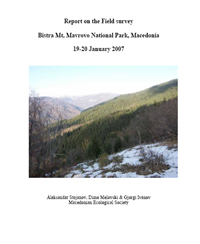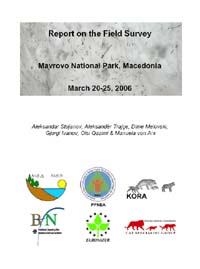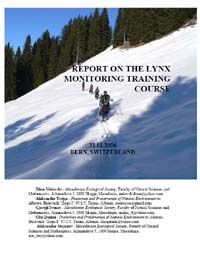|
Training Workshop
for Balkan Lynx Monitoring Network Members, Directory
of Forest Services – Librazhd, Albania. |
| PPNEA in collaboration with the Directory of Forest Services (DFS) in Librazhd organized a training workshop with foresters of Librazhdi District. The purposes of this training were to familiarize the foresters with the work of the BLRP and to introduce some concepts on lynx monitoring and signs identification. Three presentations, previously prepared by project partners and translated into Albanian (Mavrovo Monitoring Workshop – 18.02.2008, see below), were made and furthermore practical examples of camera-trapping were presented. Bearing in mind that this training was the first of its kind made in Albania, it represents a big and important step towards the creation of the monitoring network. |
|
Training Workshop
for Balkan Lynx Network members: Game wardens from the
Mavrovo National Park, Macedonia. |
| The Balkan Lynx Networks, being established in Albania and Macedonia in the frame of the Balkan Lynx Recovery Programme, aim to support the monitoring of lynx and prey and to enhance the public involvement. They consist of institutions and individuals involved in nature conservation and management, and thus being able to collect signs of wildlife presence in the field. In addition, they help to disseminate information to the local population. Interested field staff need to be trained in survey and monitoring techniques and field sign identification. A first one-day workshop has taken place on Monday, February 18, 2008 in the Mavrovo National Park, Macedonia. It was mainly addressed to the game wardens and other staff members of the park. A few additional interested people from local hunting societies and NGOs were also invited. The aims of the workshop were: 1) to familiarize network members in survey & monitoring techniques as well as field sign identification 2) to teach them about the procedure of data collection and transmission to the monitoring centre. |
|
Baseline Survey |
| Reliable information about the presence of the species concerned, its prey and habitat, as well as on the people’s attitude are a precondition for drawing up a successful recovery strategy. Therefore, a sound baseline survey was the first task tackled in the frame of the “Balkan Lynx Recovery Programme”. Procedures and working methods were predefined in an earlier meeting held in Peshtani (near Ohrid), Macedonia, June 11-13, 2006. The maps of Albania and Macedonia were overlaid with a 10x10 km grid. 62 grids in western and central Macedonia and 67 in northern and eastern Albania where chosen as study area based on the available information on lynx occurrence, and including the surrounding areas. In each grid one village was randomly selected to be visited to conduct interviews with members of different target groups (hunters, game wardens, foresters, farmers/shepherds, shop-owners and at least two randomly selected people). The questionnaire inquired several aspects in regard to large carnivores in the region: 1) presence and distribution of large mammals (carnivores and ungulates), 2) potential conflicts related with these species, 3) animal husbandry details, and 4) information on the socio-economic environment of the village. Posters and leaflets on lynx biology and status, and with information on the project (see leaflets & posters) were distributed amongst the villages. Whenever conditions were favourable, snow-tracking transects were carried out to search for indications of lynx presence. In total 553 people were interviewed in Macedonia, 320 in Albania. |
|
Analyses, presentation and reporting of the baseline survey have been discussed during a workshop in Tirana in August 2007. Further analysis are currently ongoing and first results presented to the public at the occasion of the III Congress of Ecologists of Macedonia with international participation in Struga in October 6-9, 2007. |
|
Report on the Training,
Friday, March 16 – Sunday, March 18 2007 |
| Field training was an important part of the Lynx monitoring training held in Switzerland on 13-21 March 2007. It included practical aspects of camera-trapping and finding kills of radio-collared lynx through GSM-GPS systems. The training took place in the Jura Mountains in western Switzerland where an intensive camera-trapping session has been going on during the winter. |
|
|
||
|
Report on the Field
survey Bistra Mt, Mavrovo National Park, Macedonia,
19-20 January 2007. |
|
|
||
|
Report on the Field
Survey Mavrovo National Park, Macedonia March 20-25,
2006. The aim of the survey was to carry out some transects in supposed lynx habitats in order to identify correctly and record any tracks of mammal species encountered, to get an idea about the species composition in these areas, and with the hope to find indications of lynx presence. The Mavrovo National Park is thought to be the stronghold of the Critically Endangered Balkan lynx population. Besides the numerous hares and foxes, we encountered tracks of wild boar, chamois, badger, roe deer and marten. Among the large carnivores, tracks of one bear, possibly two wolves and, on the last day, tracks of two lynx, probably a female with young, walking side by side, were found. The survey is well documented with photos; a collection for each day can be found at the end of the report. |
|
|
|
||
|
Report on the Lynx
Monitoring Training Course. For better understanding the methods, principles and aims of the monitoring, we were invited in Switzerland to see the already established monitoring programme and to learn and practice. Practical components took place in the research area in the Western Alps and various lectures were presented in the frame of the theoretical work. Demonstrations were also introduced, containing camera trapping system, lynx capture methods, skills and lynx kill identification. |
|


